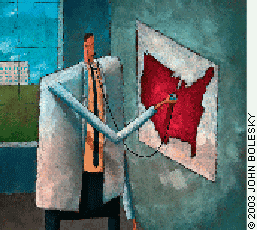
Fam Pract Manag. 2003;10(10):9

Too much bad stuff is happening in health care and to the health care system today to give optimists an easy time. The skyrocketing cost of care is bad enough, but it’s a minor, secondary problem compared with our society’s endless, rapacious appetite for more and fancier care at any cost – an appetite that comes from our fixed belief that we can live as we please as long as we have enough high-tech scans and pills and stents and lasers to make up for our unhealthy, irresponsible, gluttonous inertia. More, we have a penchant for the dramatic. We value the medicine that snatches a patient from the jaws of death more than medicine that helps keep death at a distance. We feel we deserve the ultimate in care once we’ve allowed ourselves to slide to the brink of death, and we’re incensed at the suggestion that we should pay for it.
For these reasons and undoubtedly others, we undervalue, misunderstand and misuse primary care. And as for family medicine, its generic-sounding origins and relative youth as a specialty give it an extra burden of societal ignorance and disrespect. To think that the future of family medicine can be bright and new requires either a degree of naiveté or a great deal of creative energy. Certainly, those involved in the Future of Family Medicine program (FFM) have approached the challenge of defining a new future for family medicine with a great deal of energy, and they’ve tried to face the facts, even the unpleasant ones. Their report won’t be published until early next year, when it is expected to appear as a supplement to the Annals of Family Medicine, but the results of the research they did as the first stage of the program are available now, at least informally, at http://www.futurefamilymed.org/x19431.html. And Jennifer Bush’s article in this issue (see page 43) gives you a quick tour of the highlights.
Rough road ahead
As Bush points out, the fact that the FFM project began with market research at all is significant of the specialty’s orientation toward meeting the needs of society. And the data suggest that that orientation is not lost on the public: In Bush’s words, “patients seem to want the same things family physicians want to deliver.” But the data also suggest potentially enormous challenges in increasing “brand awareness” of family medicine, in clarifying what the specialty is and does and in demonstrating its value. A third of people who think they have a family physician don’t, and even more who do see a family physician don’t realize their doctor’s specialty. Many still think that general internists receive more training than family physicians. The large majority of family physicians agree that the general patient population doesn’t know all the services family physicians are qualified to provide. A sizable proportion of the public express concerns about the difficulty of mastering the breadth of knowledge required by family medicine, and those concerns continue to be echoed in academia – by medical students, residents in other fields and, apparently, by faculty.
Keep your eyes open for the final report when it finally comes. In the end, it may well be a landmark in the development of the specialty. While it will mark the end of the project, it will very likely mark the beginning of the remaking of family medicine. Why? Because as Bush’s article points out, and as many family physicians have recognized recently, the future of family medicine will likely be bleak and wintery unless something fundamental changes.
There is a hitch, though. It appears that making the fundamental changes that the FFM report is likely to call for requires change not just in family medicine but in the health care system as a whole, and particularly the reimbursement system. While the FFM project was initially designed to encompass five task forces, a sixth was added belatedly to deal with issues of reimbursement reform. Creating a new future for a specialty is an ambitious undertaking; whether creating a new future for an entire system is too ambitious, only time will tell.